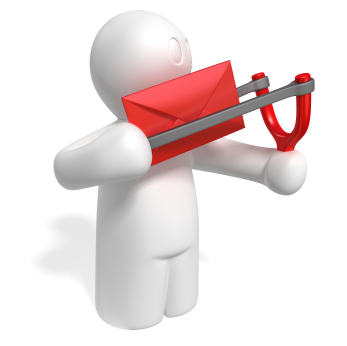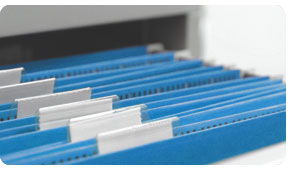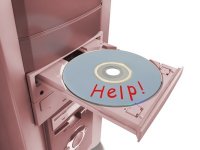 Dear
Sean
McCarthy,
10/01/2009
Welcome to the sixth edition of this newsletter -
it's a companion edition to my popular Compute This... newspaper column
in the Hometown News and I truly hope that you find it helpful.
Protect Your Identity Day Update: Last week I announced in my newsletter that we would be doing a Protect Your Identity Day with The Vero Beach Sheriffs
office on 60 just off 95.
I am sorry to have to report that the Protect Your Identity Day scheduled for October 3rd has been canceled.
I know, I know. Between the seminars and the Identity Days you would think I could get something right.
Anyways,
if you were planning to attend, thank you but don't! - no one will be
there as it has been canceled. Keep reading future newsletters and I
will let you know what date we reschedule it for.
But keep the comments and suggestions coming - I couldn't do this with out you!
And as always I hope you enjoy this weeks newsletter.
Cheers!
Sean McCarthy
|
|
Rejected emails contain clues |
 Over the last few weeks, I have gotten a number of calls from people
confused about the e-mail address that appears at the end of my
column in the Hometown News. Over the last few weeks, I have gotten a number of calls from people
confused about the e-mail address that appears at the end of my
column in the Hometown News.
The e-mail address, help@computethisonline.com often gets chopped
in half with a hyphen in the middle when the program that formats the
words for the paper breaks the address apart so it will fit on two
lines.
Consequently, what happens is people send their help requests to
the wrong e-mail address.
Here's a tip: When you see the e-mail
address (or any e-mail/web address in a publication) that is broken in
half to fit on two lines and you notice a hyphen in the middle of the
address, try sending to the address without the hyphen if you have
problems sending it with the hyphen.
That brings us to a
question: What happens to e-mail that is sent to an incorrect address?
With postal mail, we can be pretty sloppy making spelling mistakes,
leave out things like street or avenue and even leave off important
items like city and state, but as long as we have a good ZIP code and a
reasonably clear street address, the good folks over at the post office
usually figure out where it belongs and deliver it to the right address.
Not so with e-mail; an e-mail address has to be 100 percent accurate.
The
computer programs that manage the flow of mail from one computer to
another over the Internet (also known as "Mailer Daemons") don't put a
lot of extra thought into the e-mail address; either the address is
good exactly as it is typed and the message is deliverable, or it is
not correct and therefore undeliverable.
And what happens to
undeliverable mail? It gets returned to sender - just like in the real
world when the post office cannot make out an address.
But this
is where things tend to confuse people...
Continue reading >>>> |
|
Navigating around your computer |

One of the "buzzwords" you're bound to hear while learning to use your computer is "navigate."
Unfortunately,
no one ever seems to take the time to explain exactly what that means.
I thought I would use this week's newsletter to elaborate on that somewhat
mysterious term and help people understand just how important a concept
it is.
In
a nutshell, "navigating" around your PC computer simply
means finding a file or folder somewhere on your hard drive, CD/DVD
drive, floppy or USB drive. (Online however, "navigating" to a
particular Web site means
to open that Web address in your Web browser).
OK, that sounds easy
enough, but what's it really mean? How does one "navigate" to a
particular file or folder on your hard drive, CD/floppy or USB drive?
To
answer that, lets talk a bit about how information is organized on your drives and then compare that to a
regular, old fashioned file cabinet.
Each of your drives is very
similar to a file cabinet drawer in the way it stores data. Like a file
cabinet drawer, there are folders (represented, remarkably enough, by
little manila file folder icons), and there are files that are stored
in the folders.
In a real world file cabinet, when you open a
file cabinet drawer you see all of your folders stored alphabetically
from front to back. If you were looking for a particular file, you
would have to start by knowing what folder it's in and then, "navigate"
to that folder to find your file (hint: Since the folders are arranged
alphabetically, start from the front and work your way towards the back
until you find the folder that likely contains your file). Not knowing
what file you are looking for and what folder it's in can make finding
what you are looking for difficult and, unlike computers, there is no
search function built into your file cabinet.
On your computer,
each of your drives, whether it's the hard drive, floppy drive, DVD
drive, CD or removable drive - like a USB or Zip drive - is designated
by a letter followed by a colon. Your hard drive is typically
represented by a C:. Your floppy drive is usually represented by an A:.
Your CD drive is typically represented by a D:. And additional drives
will be labeled E:, F:, G:, etc.
Now, these letters can and do
vary from machine to machine but the rule is each drive gets a letter
and knowing what drive the folder or file resides on is the first step
in navigating to it.
(As a side note, you may be wondering what
happened to the B: drive. Back in the old days of computing, before
hard drives were common, machines were built to support two floppy drives.
These drives are hard coded into the system as A: and B:.
When
hard drives became commonplace, they were given the next letter in
the alphabet and became C:. After that, machines began to come out with
only one floppy drive and a hard drive; A: and C:. And that's why the
B: designation is usually not seen on today's computers and also why
the C: drive represents the hard drive.)
Back to our example...Continue reading >>>> |
10 email tips everyone should know
|

- Use a signature file to automatically... "sign" your email
- Use the Blind Co Copy (Bcc) feature to hide the address list when sending to multiple addresses
- Never email angry! Wait 24 hours before clicking send on "hot" emails
- Avoid casual use of the "reply to all" button
- Use folders to organize email
- Use message rules to automatically file email into your newly created folders
- Resist the urge to forward messages to everyone in your address book
- Answer the easy ones - If you can answer an email with a 1-2 line response then do it now.
- Avoid typing in all caps - if you have trouble reading small type increase your font size instead of using the caps-lock button
- Try to keep the size of email attachments down to 200k or less
|
|
Thank you for reading. I hate spam as much as anyone so please, if
you don't want to receive my newsletters, use the "SafeUnsubscribe"
link at the bottom of this email and you will be removed from my list. I
also appreciate your feedback. Feel free to respond to this message
with any comments you may have and I promise to reply to you as soon as
possible. An lastly, if you find my information helpful and you
overhear someone complaining about their computer, please mention my
name or forward this newsletter to them by clicking here. Most of my business is referred to me by word of mouth so without you I would not be in business. Thank you for your support.
Sincerely, Sean McCarthy
"The Mouse Whisperer"
www.ComputeThisOnline.com
Sean@ComputeThisOnline.com
772-408-0680
888-752-9049


Ps. REMEMBER! If you forward this newsletter to a friend, use the button or link above, not the forward button in your email program!
|
|
|


|
| Featured Article |

| Beware the restoration disks!
This week I thought I would write a column that will (hopefully) help someone avoid one of the pitfalls of computer ownership. What
I am to write about this week happens so frequently (it just makes me
cringe thinking about it) but it shouldn't happen at all. Especially
considering that the cause of this re-occurring problem is invariably
someone who should know better. What is it? What keeps happening to get me so riled up? I'm
talking about repeated instances of people calling factory "tech support" for
minor problems, only to have the tech-support people (who should know
better) instruct the poor, unsuspecting computer owner to format their
hard drive and start from scratch. That's like getting a lobotomy for a
headache! Then, when a user suddenly realizes all of her data is
now gone (hardly anyone makes backups, you know) the guy on the other
end of the phone casually tells her it's not his responsibility. The
above scenario does happen. A lot. I probably get two or three calls a
year from people who just got off the phone with tech support and are
left holding the pieces of a once-functional computer, now freshly
restored to it's original factory specs, with no idea how to get all
their programs, desktop and applications back in, let alone their
personal data. It's sad but avoidable. Let's cover a few points so you can be
aware when someone who is supposed to know better is about to lead you
down the road to ruin. If you ever get to the point where you
feel you need to call the computer manufacturer, remember the guy on
the other end of the phone is really busy (he takes calls like yours
all day long, every day, 40 hours a week) and he's going to want to get
your call over and done with as quickly as possible. Many times, he'll
want to speed up the process by telling you to find your "restore" or
"system restoration" disk. When he does, a bell should go off in
your head. Are you prepared to wipe out your computer's hard drive and
start from scratch? Are all of your data files backed up? (Do you have
copies of all of your Word, XL, bookmarks, e-mail addresses, etc?). Also,
consider the reason you called tech support in the first place -was it
for a relatively minor problem, such as difficulty connecting to the
Internet or maybe a printer that was acting up? If you don't have
your data backed up or the problem you called about is a minor one, you
may want to put the brakes on his proposed repair... Continue reading >>>> |
|
|